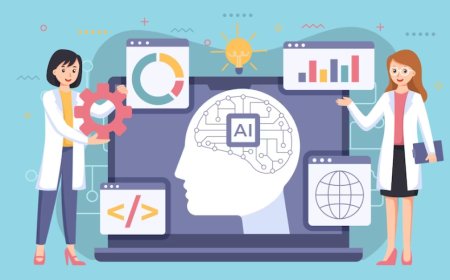Machine Learning examples in real life
Explore real-life machine learning examples across industries, including healthcare, finance, retail, and more. Discover practical applications and insights.

Decision-making and processes have been changed by machine learning, which has touched many industries. Through data analysis of medical imaging, it helps with disease diagnosis and treatment planning in the healthcare industry. Algorithms for risk management and fraud detection are beneficial to finance. Systems for making suggestions customize user experiences on websites like Netflix and Amazon. Chatbots and translation services are powered by natural language processing. Safe navigation in autonomous vehicles is dependent on machine learning.
Imagine a real-life situation in which a hospital uses machine learning algorithms to diagnose patients and recognize cancer early on. These algorithms employ pattern recognition to carefully examine large datasets of medical images, including MRIs and X-rays, to identify minute errors that may be signs of cancer. Quick detection of these anomalies allows medical practitioners to intervene early and customize treatment regimens to meet the needs of each patient. This raises the probability of a successful course of therapy, eases the strain on medical resources, and promotes patient care generally.
Challenges in machine learning in our daily life
-
Data Quality and Quantity: Obtaining high-quality and sufficient data is crucial for training accurate machine learning models. In many real-life applications, collecting and labeling data can be expensive, time-consuming, and prone to errors.
-
Privacy and Security Concerns: Machine learning algorithms often require access to sensitive personal or proprietary data. Ensuring the privacy and security of this data while still extracting meaningful insights presents significant challenges.
-
Algorithm Bias and Fairness: Machine learning algorithms may inadvertently perpetuate or amplify biases present in the training data, leading to unfair or discriminatory outcomes. Addressing algorithmic bias and ensuring fairness in decision-making is a complex and ongoing challenge.
-
Interpretability and Explainability: Many machine learning models, particularly complex deep learning models, are often seen as "black boxes," making it difficult to interpret their decisions or predictions. Ensuring transparency and explainability in machine learning systems is essential, especially in high-stakes applications like healthcare and finance.
-
Adaptability and Robustness: Machine learning models trained on historical data may struggle to adapt to changing conditions or unforeseen scenarios. Building models that are robust to variations in data distribution and capable of continuous learning is a significant challenge.
-
Computational Resources and Infrastructure: Training and deploying machine learning models often require significant computational resources and infrastructure, which may be prohibitive for smaller organizations or individuals. Optimizing algorithms for efficiency and scalability is essential to overcome these challenges.
-
Ethical and Regulatory Considerations: Machine learning applications raise various ethical and regulatory concerns, particularly regarding issues such as data privacy, fairness, accountability, and transparency. Ensuring compliance with relevant laws and ethical guidelines is essential for the responsible deployment of machine learning systems.
-
Human-Machine Interaction: Integrating machine learning systems into daily life requires seamless interaction between humans and machines. Designing intuitive user interfaces and incorporating user feedback into the learning process is crucial for effective human-machine collaboration.
Which places we can find machine learning in our daily life
-
Healthcare: Machine learning algorithms can analyze medical data to assist in diagnosing diseases, predicting patient outcomes, and suggesting personalized treatment plans. For instance, algorithms can analyze medical images like X-rays and MRIs to detect abnormalities or assist in early cancer detection.
-
Finance: In finance, machine learning is used for fraud detection, algorithmic trading, credit scoring, and risk management. Algorithms can analyze large datasets to detect unusual patterns that may indicate fraudulent activities or predict stock market trends.
-
Recommendation Systems: Online platforms like Amazon, Netflix, and Spotify use machine learning algorithms to provide personalized recommendations to users based on their past interactions and preferences. These algorithms analyze user behavior and historical data to suggest products, movies, or songs that users are likely to be interested in.
-
Natural Language Processing (NLP): NLP techniques are used to analyze and understand human language. Applications include sentiment analysis, language translation, chatbots, and voice recognition systems like Siri and Google Assistant.
-
Autonomous Vehicles: Machine learning algorithms are crucial for autonomous vehicles to perceive their surroundings, make decisions, and navigate safely. These algorithms analyze data from sensors such as cameras, LiDAR, and radar to identify objects, predict their movements, and plan optimal routes.
-
Manufacturing: Machine learning is used in manufacturing for predictive maintenance, quality control, and supply chain optimization. By analyzing data from sensors and machinery, algorithms can predict equipment failures before they occur, detect defects in products, and optimize production processes.
-
Image and Speech Recognition: Machine learning algorithms can analyze images and audio to recognize objects, faces, and speech. Applications include facial recognition for security purposes, object detection in autonomous vehicles, and speech-to-text conversion for virtual assistants.
-
Social Media and Marketing: Social media platforms use machine learning algorithms to personalize content feeds, target advertisements, and detect spam or inappropriate content. These algorithms analyze user behavior, preferences, and interactions to deliver relevant content and advertisements.
-
Climate Prediction: Machine learning is used in climate science to analyze historical climate data and make predictions about future climate patterns. These predictions help scientists understand climate change, assess its impacts, and develop strategies for mitigation and adaptation.
-
Genomics: Machine learning techniques are used in genomics to analyze DNA sequences, identify genetic variations, and predict the likelihood of diseases. These algorithms help researchers understand the genetic basis of diseases and develop personalized treatments.
Machine learning is changing the way we live in several sectors, including healthcare, banking, entertainment, and transportation. Machine learning algorithms provide more precise diagnoses, tailored suggestions, safer transportation, and increased industrial process efficiency by utilizing the power of data analysis and pattern identification. To guarantee the appropriate and moral application of machine learning technology, however, issues like algorithm bias, privacy problems, and poor data quality must be resolved. Despite these obstacles, machine learning is becoming widely used and is revolutionizing our way of life, our jobs, and our interactions with technology. This indicates that the future is full of possibilities and innovation.



































